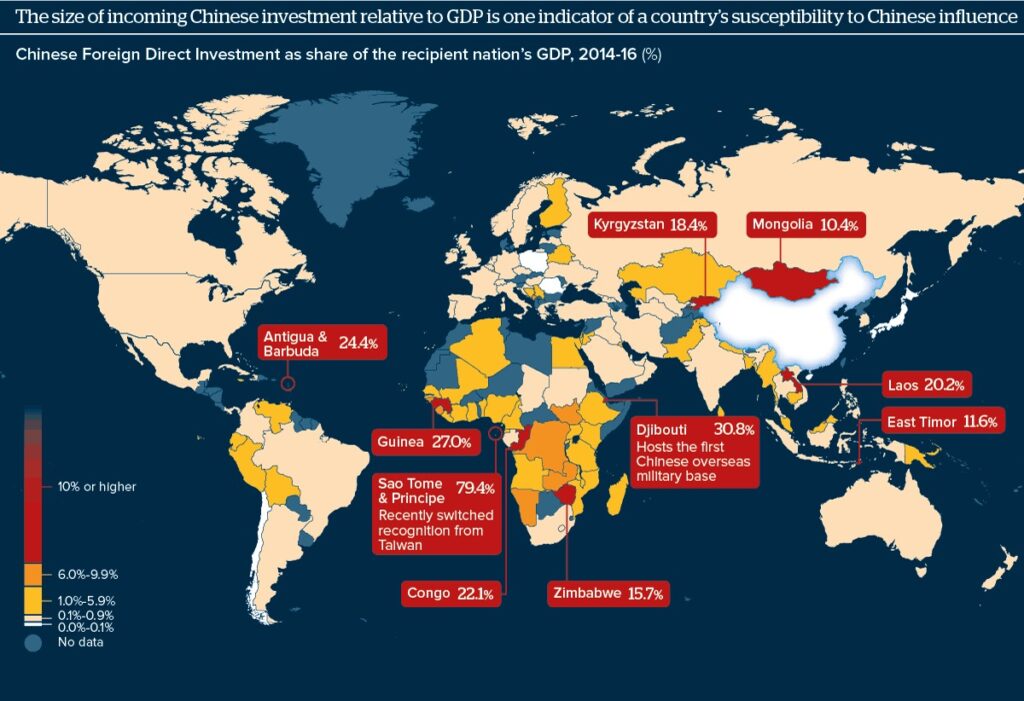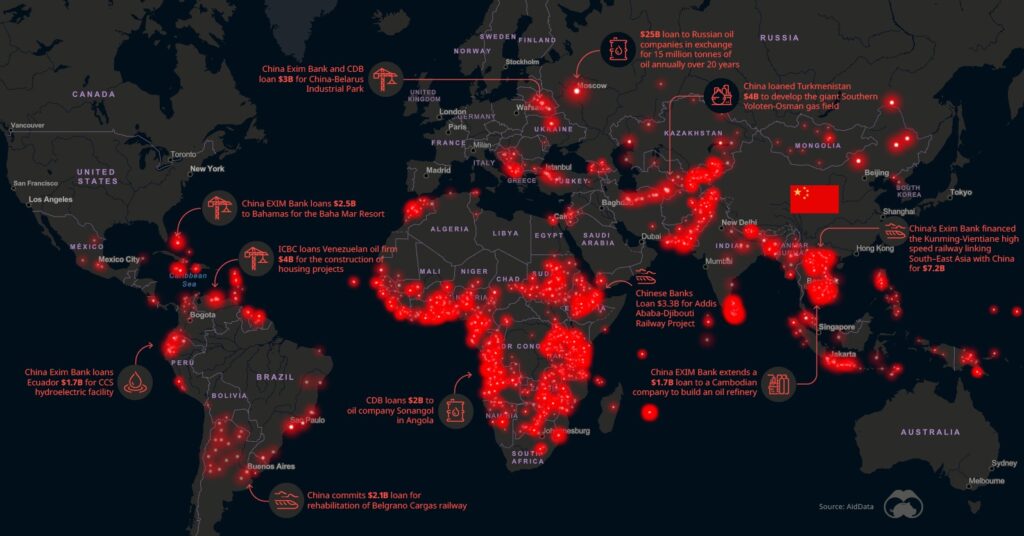
In the last few decades, China’s subtle but incredibly increasing multi-dimensional influence in countries across the globe has been the single most trailblazing phenomenon in the international order.

From investments in infrastructure in economically and developmentally lacking countries to instalment of its media and digital surveillance architecture overseas, this ambitious attempt of building global hegemony ‘with Chinese characteristics’ has garnered all kinds of debates and definitions. However, as talked about as this development is, sometimes with fascination, sometimes with paranoia, systematic, evidence-based tools to map and quantify it remain wanting. This is precisely where the actions of the Taiwan-based think tank Doublethink Lab are directed, particularly, through their China Index project.
Under the China Index initiative, the research group evaluates the Communist Party of China’s (CCP) activities and publishes comparative data analysis using observable inputs from regional partners and local experts, across nine different domains of influence. These are academia, domestic politics, economy, foreign policy, law enforcement, media, military, society, and technology. The current version of the index compiles data collected between January 2022 to October 2024 from 101 countries spanning 9 regions. The index, in addition to cumulative assessments, maintains country-specific ‘influence profiles’ that detail the extent of the PRC’s penetration into a given country, corroborated by supporting evidence in the form of links to news and other research reports.

Unsurprisingly, the country that leads the overall ranking as well as the regional ranking in South Asia is Pakistan, preserving its streak since the 2022 China Index report. Bonding over their shared rivalry with India, Pakistan’s existential dependence on China for economic support and supply of military equipment, the Belt and Road Initiative (BRI), as well as their joint attempts to safeguard each other against global efforts to enforce counterterrorism and human rights measures, the two have forged a deep strategic partnership. Following Pakistan in the region is Nepal with its overall ranking at 11. Again, Chinese interests in Nepal are primarily motivated by the strategy of counteracting the Indian influence in the country which is a result of centuries-old religious, cultural, geographical, and linguistic ties. Over the past decade, China has been quietly expanding its reach into the small Himalayan nation’s economy, domestic politics, society, education, and military assistance. However, it has also attracted some criticism for its interference in local municipal elections and worsening Nepal’s debt perils, as in the case of the Pokhara International Airport. In addition, it is believed to be using its research centres in Nepal to spy on India.
After Pakistan, the 2nd, 3rd and 5th overall rankings are all occupied by countries in the East and Southeast Asia- namely, Cambodia, Singapore, and Thailand, respectively. As per the index, China is currently focused on penetrating further into Cambodian sectors of media, academia, and science/technology as the other sectors, including economy (China being Cambodia’s largest trading partner in goods), society (both countries have signed MoU Chinese language curricula in Cambodian schools), law enforcement (both maintain an extradition treaty), and military assistance have already been sufficiently fortified. Similarly, Singapore demonstrates heavy PRC presence in all sectors, but military due to its traditional reliance on US and NATO military gear. The index highlights Singapore’s susceptibility to disinformation from the PRC on account of the overwhelming permeation of PRC-related media, casting doubts on the integrity of even Singapore state-owned media. So is the story of Thailand where many fear their country being reduced to a satellite state of China.
When it comes to the African continent, the skyrocketing Chinese economic penetration is quite well-known and well-feared. For 16 years now, China has held on to the status of Africa’s largest bilateral trading partner. At the same time, it is also the continent’s biggest bilateral creditor and among the leading foreign investors. This pivot to Africa has been driven by a multitude of factors- tapping into the continent’s abundant natural resources, accessing a lucrative market for Chinese manufactured goods, and the BRI. Expectedly, over these years, China has also received much scrutiny and censure for economically entrapping the vulnerable African nations through its ill-famed debt-trap diplomacy, in addition to entrenching its media and surveillance machinery so as to both bolster its narrative and export its authoritarian technologies. In the China Index’s assessment too, Nigeria bags the 4th overall ranking on the back of its critical economic relationship with the PRC (which also controls critical infrastructure in the country like the Lekki Deep Sea port), Chinese media presence (with Chinese state media also being broadcast in Nigerian languages), and import of defence arsenal and surveillance technologies. Interestingly, China also owns up to 86% of Nigerian bilateral debt. As mentioned above, this is a prevalent pattern in China’s engagement with Africa, for instance, Uganda, which ranks 25 in the index, owes 75% of its bilateral sovereign debt to the PRC, and the corresponding number for Kenya, at rank 14, is 73%. Even the countries that are not economically beholden to China through massive debt appear to open themselves to its influence due to elite interests (like in the case of Zimbabwe, rank 6) or geopolitical considerations (like South Africa, rank 10). In the north African region too, China demonstrates profound ties with countries like Algeria, rank 9 (spanning sectors like military, manufacturing, knowledge economy, and agriculture) and Egypt, rank 19 (specifically in the domains of military cooperation and cultural and educational exchanges).

In recent years, particularly under Mohammed Bin Salman, China has made great strides in its engagement with Saudi Arabia, ranked at the 28th spot in the index. This relationship entails economic cooperation, academic and cultural association (for instance, the Saudis imparting he Chinese language in schools), and technological exchange, such as the Huawei’s entrenchment in the Saudi market for 5G or the ongoing proposals for smart-city cooperation and AI. As is seen with countries that become too friendly with China, Saudi Arabia also supports Chinese positions on Xinjiang and Taiwan.
Furthermore, as far across as Latin America too, China has managed to establish deep dependencies. Notably, in the case of countries leading the region as per the index such as Chile (rank 8), Argentina (rank 15), Venezuela (rank 17), and so on, China does not just lead with its economic heft but also proactively targets the domains of media and academia, domestic politics, and foreign policy.
While studying Chinese growing global dealings, analysts contend that authoritarian or semi-democratic regimes are easier to give way to the PRC’s machinations. While it is true that robust democratic institutions act as a bulwark against attempts at stifling free thought and expression, well-established democratic countries are not completely immune to this Chinese adventurism. For instance, Canada, at rank 19, displayed an incredible Chinese permeation in media and academia (with 22 Canadian media outlets belonging to the World Chinese Media network), with a significant expansion in other critical sectors like domestic politics, military, and law enforcement. Similarly, Germany, ranked 22, too has shown vulnerability to the PRC’s tactful advances, specifically in economy and to some degree, in media and society. In fact, even the superpower of the world, the United States stood at rank 38 as its domains of academia, economy, technology, and law enforcement suffer from surreptitiously surging Chinese influence, as exhibited by the index.
There is a term for this strategy in internation relations. It is called ‘sharp power’. In contrast to hard power, which entails military and/or economic coercion, and soft power, which refers to gaining influence through attraction or persuasion, sharp power is deployed by typically authoritarian states to build international influence by manipulating political systems, compromising democratic integrity, and promoting an interest-based culture of censorship. While it is true that even democratic countries are not inert to this advancing storm, they have shown remarkable resilience to the PRC’s deceitful ways. The China Index, in the current global context, has emerged as a tool of paramount importance and urgency. In this age of increasing export of China’s data-driven authoritarianism, political interference, debt-perils, and assault on the liberal normative order, a data-based documentation of its methods is not only revelatory but a forewarning. The world must act, and it must act now.